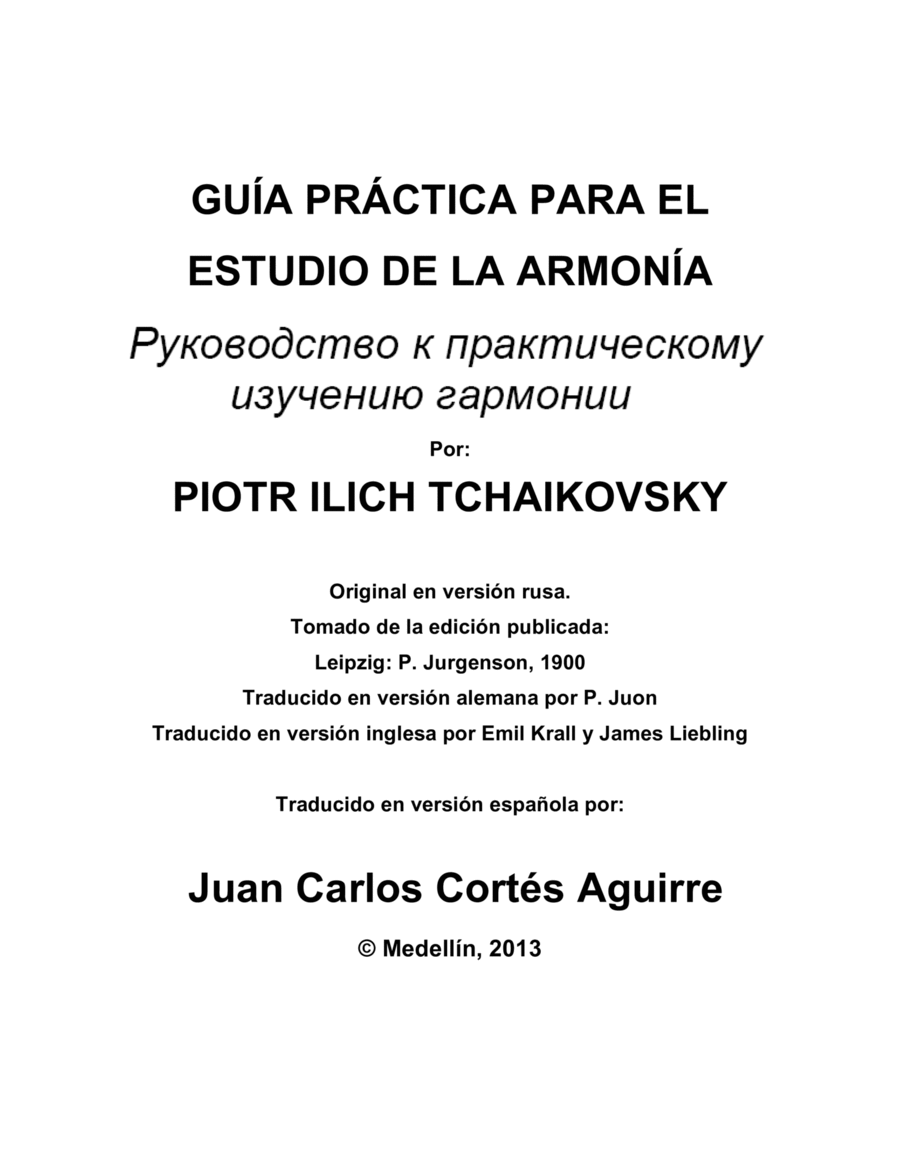Choral Choir (Mixed) - Level 3 - Digital Download SKU: A0.958765 Composed by Peter Ilyich Tchaikovsky. Arranged by Juan Carlos CortĆ©s A. Instructional,Romantic Period,World. Octavo. 234 pages. Juan Carlos CortĆ©s Aguirre #6473855. Published by Juan Carlos CortĆ©s Aguirre (A0.958765). TraducciĆ³n al idioma EspaƱol (Castellano) de la obra pedagĆ³gica musical GuĆa prĆ”ctica para el estudio de la armonĆa por Piotr Ilich Tchaikovsky (VĆ³tkinsk, 7 de mayo de 1840 - San Petersburgo, 6 de noviembre de 1893), compositor ruso del Siglo XIX basado en la versiĆ³n rusa, luego traducida a los idiomas AlemĆ”n e InglĆ©s. Obra amparada por el Ā© Copyright como Derecho Conexo que otorga protecciĆ³n a quienes, sin ser autores, contribuyen con creatividad, tĆ©cnica u organizaciĆ³n, en el proceso de poner a disposiciĆ³n del pĆŗblico una obra.VĆDEOS:VIMEO:https://vimeo.com/679341606ŠŠµŃŠµŠ²Š¾Š“ Š½Š° ŠøŃŠæŠ°Š½ŃŠŗŠøŠ¹ (ŠŗŠ°ŃŃŠøŠ»ŃŃŠŗŠøŠ¹) ŃŠ·ŃŠŗ Š¼ŃŠ·ŃŠŗŠ°Š»ŃŠ½Š¾-ŠæŠµŠ“Š°Š³Š¾Š³ŠøŃŠµŃŠŗŠ¾Š³Š¾ ŃŠ¾ŃŠøŠ½ŠµŠ½ŠøŃ Ā«ŠŃŠ°ŠŗŃŠøŃŠµŃŠŗŠ¾Šµ ŠæŠ¾ŃŠ¾Š±ŠøŠµ ŠæŠ¾ ŠøŠ·ŃŃŠµŠ½ŠøŃ Š³Š°ŃŠ¼Š¾Š½ŠøŠø ŠŠµŃŃŠ° ŠŠ»ŃŠøŃŠ° Š§Š°Š¹ŠŗŠ¾Š²ŃŠŗŠ¾Š³Š¾ (ŠŠ¾ŃŠŗŠøŠ½ŃŠŗ, 7 Š¼Š°Ń 1840 Š³. - Š”Š°Š½ŠŗŃ-ŠŠµŃŠµŃŠ±ŃŃŠ³, 6 Š½Š¾ŃŠ±ŃŃ 1893 Š³.), ŃŃŃŃŠŗŠ¾Š³Š¾ ŠŗŠ¾Š¼ŠæŠ¾Š·ŠøŃŠ¾ŃŠ° XIX Š²ŠµŠŗŠ°. Š ŃŃŃŠŗŠ°Ń Š²ŠµŃŃŠøŃ, Š·Š°ŃŠµŠ¼ ŠæŠµŃŠµŠ²ŠµŠ“ŠµŠ½Š½Š°Ń Š½Š° Š½ŠµŠ¼ŠµŃŠŗŠøŠ¹ Šø Š°Š½Š³Š»ŠøŠ¹ŃŠŗŠøŠ¹ ŃŠ·ŃŠŗŠø. Š Š°Š±Š¾ŃŠ° Š·Š°ŃŠøŃŠµŠ½Š° Š°Š²ŃŠ¾ŃŃŠŗŠøŠ¼ ŠæŃŠ°Š²Š¾Š¼ Ā© ŠŗŠ°Šŗ ŃŠ¼ŠµŠ¶Š½Š¾Šµ ŠæŃŠ°Š²Š¾, ŠŗŠ¾ŃŠ¾ŃŠ¾Šµ Š¾Š±ŠµŃŠæŠµŃŠøŠ²Š°ŠµŃ Š·Š°ŃŠøŃŃ ŃŠµŠ¼, ŠŗŃŠ¾, Š½Šµ ŃŠ²Š»ŃŃŃŃ Š°Š²ŃŠ¾ŃŠ°Š¼Šø, Š²Š½Š¾ŃŠøŃ ŃŠ²Š¾Š¹ ŃŠ²Š¾ŃŃŠµŃŠŗŠøŠ¹ Š²ŠŗŠ»Š°Š“, ŠøŃŠæŠ¾Š»ŃŠ·ŃŃ ŃŠµŃ
Š½ŠøŠŗŃ ŠøŠ»Šø Š¾ŃŠ³Š°Š½ŠøŠ·Š°ŃŠøŃ, Š² ŠæŃŠ¾ŃŠµŃŃŠµ ŠæŃŠµŠ“Š¾ŃŃŠ°Š²Š»ŠµŠ½ŠøŃ Š¾Š±ŃŠµŃŃŠ²ŠµŠ½Š½Š¾ŃŃŠø Š Š°Š±Š¾ŃŠ°.Ćbersetzung in die spanische Sprache (Kastilisch) des musikpƤdagogischen Werks Praktischer Leitfaden fĆ¼r das Studium der Harmonielehre von Pjotr āāIljitsch Tschaikowsky (VĆ³tkinsk, 7. Mai 1840 - Sankt Petersburg, 6. November 1893), russischer Komponist des 19. Russische Version, dann in die deutsche und englische Sprache Ć¼bersetzt.. Werk geschĆ¼tzt durch Ā© Copyright als verwandtes Recht, das denjenigen Schutz gewƤhrt, die, ohne Autoren zu sein, mit KreativitƤt, Technik oder Organisation einen Beitrag zur ƶffentlichen ZugƤnglichmachung leisten a Arbeit.Translation into Spanish language (Castilian) of the musical pedagogical work Practical guide for the study of harmony by Pyotr Ilyich Tchaikovsky (VĆ³tkinsk, May 7, 1840 - Saint Petersburg, November 6, 1893), Russian composer of the XIX century based in the Russian version, later translated into the German and English languages. Work protected by Ā© Copyright as a Related Right that grants protection to those who, without being authors, contribute with creativity, technique or organization, in the process of making available to the public a work.Traduzione in lingua spagnola (castigliano) dell'opera di pedagogia musicale Guida pratica per lo studio dell'armonia di Pyotr Ilyich Tchaikovsky (VĆ³tkinsk, 7 maggio 1840 - San Pietroburgo, 6 novembre 1893), compositore russo del XIX secolo con sede nel Versione russa, poi tradotta in lingua tedesca e inglese Opera protetta da Ā© Copyright as a Related Right che garantisce protezione a coloro che, senza essere autori, contribuiscono con creativitĆ , tecnica o organizzazione, nel processo di messa a disposizione del pubblico di un lavoro. Traduction en espagnol (castillan) de l'ouvrage de pĆ©dagogie musicale Guide pratique pour l'Ć©tude de l'harmonie de Piotr Ilich TchaĆÆkovski (Votkinsk, 7 mai 1840 - Saint-PĆ©tersbourg, 6 novembre 1893), compositeur russe du XIXe siĆØcle, basĆ©e sur la version russe, traduite ultĆ©rieurement en allemand et en anglais. L'Åuvre est couverte par le Ā© Copyright en tant que droit voisin qui accorde une protection Ć ceux qui, sans ĆŖtre des auteurs, contribuent de maniĆØre crĆ©ative, technique ou organisationnelle au processus de mise Ć disposition d'une Åuvre au public.
